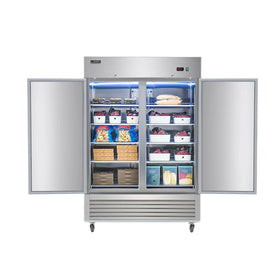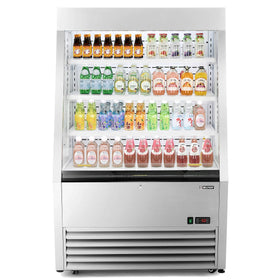On average, you can expect an air-curtain refrigerator to consume anywhere from 200 to 1,500 kWh per month: electricity consumption depends on the size of the unit, how (often) it is used, and whether or not it is designed to be energy efficient.
Generally, the electricity consumption of commercial open-air refrigerators is proportional to their size: smaller commercial open-air refrigerators consume less electricity than larger units.
However, the size of an open-air refrigerator is not the only indicator of how much electricity it will consume in a month. Like any other commercial refrigerator, an open-air merchandiser will naturally consume significantly more electricity if it is used for extended periods and/ or in a hotter and humid environment, for example.
So, to determine how much electricity an open-air refrigerator will consume in a month, start by ascertaining its size/model and then consider other factors like where it will be used, how energy efficient it is, etc.

Open-Air Refrigerator Electricity Consumption By Size
| Size Category | Cubic Feet Range | Avg. Monthly Energy | Est. Electricity Cost ($0.13/kWh) | Est. Electricity Cost ( $0.20/kWh) | Typical Use |
| Small | Under 20 cu. ft. | 200-400 kWh | $26-$52 | $40-$80 | Countertop, grab-and-go, cafés |
| Medium | 20–50 cu. ft. | 400-800 kWh | $52-$104 | $80-$160 | Small shops, single/narrow multi-deck |
| Large | 50–100 cu. ft. | 800-1,500 kWh | $104-$195 | $160-$300 | Grocery stores, wide multi-deck |
| Extra-Large | 100+ cu. ft. | 1,500-3,000+ kWh | $195-$390+ | $300-$600+ | Supermarkets, aisle-length or island cases |
Notes
- The $0.13/kWh in the figure reflects the May 2025 U.S. commercial average (12.96¢/kWh) from the U.S Energy Information Administration (EIA); use your local utility rate for a precise estimate.
- Here's a quick formula: Monthly Cost = kWh × local $/kWh.
Understand Open-Air Refrigerator Sizes
A larger open-air curtain refrigerator has a greater volume to cool, more surface area, higher airflow demand, and needs more frequent compressor cycling; hence, it consumes more electricity.
If electricity consumption is a major concern of yours, you must ensure that you pick an air curtain merchandiser that matches the size of your business.
Different air-curtain refrigerator sizes match different store types.
| Size Category | Cubic Feet Range | Best Suited Businesses |
| Small | Under 20 cu. ft. | Cafés, coffee shops, bakeries, small delis, gas stations |
| Medium | 20–50 cu. ft. | Convenience stores, quick-service restaurants, and small grocery sections |
| Large | 50–100 cu. ft. | Supermarkets, full-service grocery stores, specialty food stores |
| Extra-Large | 100+ cu. ft. | Large supermarkets, warehouse clubs, wholesale retailers |
Open-Air Refrigerator Sizes For Small and Medium Businesses
1. Wilprep 36" Vertical Air Curtain Merchandiser
Wilpreps' 36" Vertical Air Curtain Merchandiser offers a total volume of 12.2 cu. ft. and features 3 height and tilt adjustable shelves to hold canned soda, bottled water, beer, yogurt, or pre-packaged sandwiches.
It comes with a quality compressor and a pull-down night curtain to ensure your offerings stay fresh and cold at 30-46°F with minimal electricity costs. You even get digital controls to make temperature adjustments and a built-in LED lighting.
It is made of solid and durable 430 stainless steel and reinforced with double-layered tempered glass.
2. Wilprep 59" Black Vertical Air Curtain Merchandiser
Grocery stores and Supermarkets rely on large or extra-large units. For a medium-sized model, consider this 59" Black Vertical Air Curtain Merchandiser from Wilprep. It offers a total volume of 22.2 cu. ft. and features four height-adjustable shelves, each with a 66 lb capacity.
It comes with a quality SECOP compressor and finned copper tube condenser that work together to ensure your offerings stay fresh and cold at 30-50°F with minimal energy costs. You also get a pull-down night curtain to minimize electricity consumption while the unit is not being used.
How to Reduce Electricity Consumption in an Air-Curtain Refrigerator
1. Use Night Curtains
A night curtain is a barrier that rolls down in front of the open display when the store is closed.
Using a night curtain is great for reducing electricity consumption: the curtain prevents cold air from escaping, so the refrigerator doesn’t have to work as hard to maintain temperature.
This can save a noticeable amount of energy over time.
In fact, if you are going to purchase an air-curtain refrigerator, a night curtain should be one of the principal features to look for.
2. Clean the Condenser Regularly
The condenser releases heat from inside the refrigerator to the surrounding air. When dust, grease, and debris build up on the coils, it reduces efficiency.
Cleaning it frequently is a great way to ensure better heat transfer, so the compressor doesn’t overwork, lowering electricity consumption.
3. Control Placement Density / Avoid Blocking Airflow
How you place your products within an air-curtain merchandiser matters. Products placed too close together or in front of vents can obstruct airflow.
Poor airflow forces the system to run longer to maintain even cooling, which uses more electricity. To avoid this problem, keep shelves spaced and vents clear for optimal circulation.
The best air-curtain refrigerators, especially larger models, are designed to help you with proper product placement and airflow. In addition to eight height-adjustable shelves (each with a 66 lb capacity), this 76" Black 3 Sided Glass Display Refrigerator from Wilprep comes with shelf label strips that make product labeling and pricing easy and organized. Moreover, the back panel is perforated to boost airflow and keep all items evenly chilled from all sides.
4. Maintain Proper Temperature Settings
Setting the fridge colder than necessary doesn’t improve food safety but does increase electricity use. So, to maximize energy efficiency, always set the refrigerator to its required temperature.
For most open-air refrigerators, the required temperature falls within the range of 30-50°F (depending on what is stored in the unit). However, always follow manufacturer or regulatory guidelines for ideal temperature ranges.
Remember: setting the temperature lower is counterproductive as far as saving electricity costs is concerned
5. Always Check Door Seals and Air Leaks
Damaged or loose door seals allow cold air to escape and warm air to enter. This makes the compressor run more often, raising electricity costs. So, always inspect seals regularly and replace them if worn or damaged.
Again, the quality of door seals should be a crucial factor when you are considering which air curtain refrigerator to get for your business.
6. Regular Maintenance and Servicing
Professional check-ups can identify problems like low refrigerant, failing fans, or worn components. Catching these issues early prevents the system from overworking and consuming excess electricity.
Remember, cleaning and serving a commercial fridge is a duty you must perform as often as you can, which is often about every 2-3 months
In short, keeping cold air in, airflow unobstructed, components clean, and temperatures optimized is the key to cutting electricity costs while keeping products safely chilled.
Common Questions About Air-Curtain Refrigerator Electricity Consumption
1. Can Air-Curtain Refrigerators Operate 24/7
Yes, in fact, air-curtain refrigerators are designed to run continuously to keep products at safe temperatures. The open-front design and air curtain mean the fridge constantly compensates for warm air entering, so it typically runs 24/7 in retail environments.
However, it is wise to take measures to minimize electricity consumption even while your air curtain refrigerator operates 24/7. Using night curtains after hours and proper maintenance can reduce electricity costs even during continuous operation.
2. Do air-curtain Refrigerators Consume More Electricity than Glass-door Refrigerators?
Yes. Air-curtain refrigerators typically use more electricity than glass-door refrigerators. Glass-door refrigerators are more energy-efficient because they contain cold air, while air-curtain refrigerators trade efficiency for open access and product visibility.
However, remember that most businesses make their money from impulse buying, and open-air refrigerators are better for inducing sales.
Besides, you can always follow the above tips to boost energy efficiency with an open-air refrigerator.
Final Words
Again, when it comes to the electricity consumption of open-air refrigerators, remember that it is proportional to their size: a smaller commercial open-air refrigerator will almost always consume less energy than a larger unit. So, it is important to match the refrigerator size to the needs of your business.
However, also remember that the size of an open-air refrigerator is not the only indicator of how much electricity it will consume in a month. If you fail to take proper care of the refrigerator or place the items in such a way that the air flow is obstructed, your open-air refrigerator will end up consuming more electricity.










